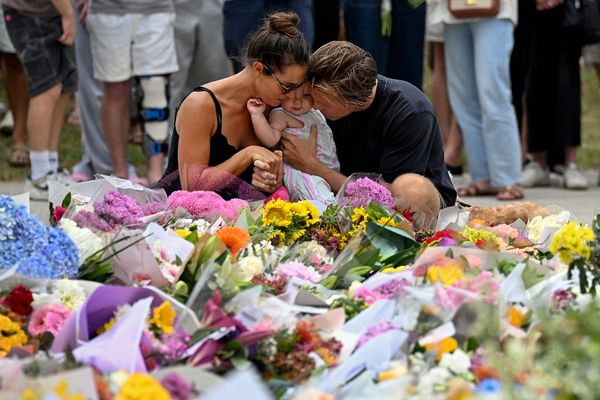
Alone in the Arctic, surrounded by disappearing sea ice … few fables of the climate crisis are better known than the plight of the polar bear. The marine mammals are heavily dependent on sea ice for hunting, and as the Arctic warms, scientists warn they will become extinct across much of the region.
Long term declines have already been recorded in three of the 19 polar bear subpopulations found across the Arctic, including those in the western part of Hudson Bay in Canada – among the most southerly populations – whose numbers dropped from an estimated 842 to 618 between 2016 and 2021.
But some researchers warn that this “accidental” symbol of the climate crisis is unhelpful and not universally true so far, and can undermine conservation efforts by driving mistrust with some Indigenous communities in the Arctic. They say other species are better suited as symbols of wildlife threatened by a warming world.
“It’s easier to tell the public simple stories: the sea ice is melting so polar bears are doing worse. But biology and ecology are very complicated,” says Prof Jon Aars, who has been leading polar bear research at the Norwegian Polar Institute on Svalbard since 2003.
The Norwegian archipelago is the most rapidly warming part of planet Earth. Temperatures there have risen 4C on average in the past 50 years and a massive amount of sea ice has disappeared, raising fears for the survival of the 300 bears that are based there, part of a wider Barents Sea population of around 3,000 between Svalbard and the Franz Josef Land islands in Russia.

Despite this dramatic change in conditions, however, the polar bear population on Svalbard has yet to experience a decline. This could be because the mammals are still recovering from the pressures of hunting, which was banned in Norway in 1973, and Aars does not rule out a future collapse. There is growing evidence that the bears are switching hunting practices – targeting reindeer as well as seals, a change that was first documented on the archipelago in 2021. “Denning” – behaviour around making dens – has changed and bears are swimming long distances, but, says Aars, there is still enough sea ice in the spring for the bears to hunt successfully.
“I have to say that I’m a bit surprised that polar bears do so well in Svalbard because the changes have been so big. They have three to four months’ less sea ice now than three decades ago on average, which is a lot. If someone told us 20 to 30 years ago that the ice would be in this situation, most of us would have guessed that polar bears would have done worse than they’re actually doing,” he says.
The complicated global perspective of the estimated 26,000 wild polar bears – which has big data gaps in Russia and parts of Greenland – has much to do with types of sea ice, which are grouped into four ecoregions – seasonal, divergent, convergent and archipelago – according to Dr Steven Amstrup, chief scientist emeritus at Polar Bears International. In Hudson Bay, where the ice is seasonal, longer fasting periods are forcing bears to come on shore, where there is little to eat.
In Svalbard, the ice moves away from the shore in summer, creating a divergent ecoregion where the picture is uncertain. The Norwegian archipelago is surrounded by the rich waters of a continental shelf and in spring – the crucial hunting season for polar bears – there is enough coverage for them to find seal pups. In the Beaufort Sea near Alaska, which is also in the divergent group, however, where the waters are among the least productive in the Arctic and support fewer seals, the polar bear populations are struggling.
“We can’t talk about a global state of the bears [because of the data gaps],” says Prof Andrew Derocher, a polar bear expert at the University of Alberta, who authored some of the early studies about the effect of climate change on polar bears. “You have to take a more subpopulation perspective. Some are doing well, some are not. This creates a lot of confusion working with Inuit hunters in Canada who say they’re seeing lots of bears. I say, ‘Yes, because you live in an area where there are lots of bears but there are other places where they are not doing as well’.”

Last year, the situation was further complicated with the discovery of what appears to be a 20th isolated subpopulation in Greenland that has adapted to use ice from glaciers to aid hunting.
“In the Canadian context, the polar bear being a symbol of climate change has caused a lot of problems,” Derocher says. “We used to have a good relationship with Inuit hunters. A lot of the hunters that I know think that polar bears will do OK with climate change and it has created some interesting tensions.”
Although Derocher is pessimistic about the future for many subpopulations, including the bears in Svalbard, he says: “We’ve got areas of polar bear distribution that are going to be quite robust to the effects of climate change. I always say polar bears are an accidental icon of climate change. It’s not a ‘skies falling’ scenario or Chicken Little time. But what we have to do is look at our trajectories decades into the future.”
Under a high-emissions scenario, many subpopulations could disappear entirely this century, warn some scientists. Derocher says that the popular tale of the polar bear is likely to play out, increasing human-wildlife conflict as polar bears starve, with a rise in deaths, such as the recent attack on three people in Quebec In the two remaining ice ecoregions – convergent, where separate pieces of ice merge, and archipelago, where there is the most ice coverage – polar bears are expected to do okay.
“We have 19 populations of polar bears across the Arctic and 19 different scenarios are playing out over time,” says Derocher. “I think that our best analysis is that all of those are not going extinct this century.”
Find more age of extinction coverage here, and follow biodiversity reporters Phoebe Weston and Patrick Greenfield on Twitter for all the latest news and features







